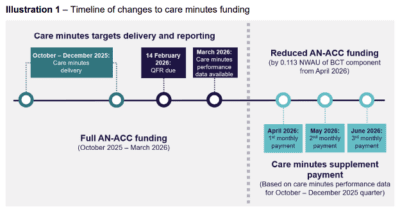The Royal Commission release of the Aged Care Quality and Safety Report in 2021 initiated the creation of the Care Minutes Act. Focused on providing each aged care resident with elevated care, the Act dictates a minimum number of care minutes per patient daily and an adequate staffing level at any given time.
After the initial introduction of 200 minutes of care per patient daily in 2021, this increased to 215 minutes starting October 1, 2024. Along with the increase in Care Minutes per patient, a registered nurse (RN) is required to provide 44 minutes of direct care per patient daily. Between July and September 2024, the Department of Health and Aged Care developed a report which shows that only 45% of aged care providers were meeting both Care Minutes and RN targets.
Due to the underwhelming results across most Aged Care providers, the Australian Government has passed additional changes that if Aged Care providers do not demonstrate their targets are being met for either Care Minute targets and RN targets from their October-December 2025 Quarterly Financial Report will have their Care Minute supplement and overall funding from the Australian Government reduced starting April 2026.
The new reporting requirements are designed to ensure proper quality care and manage the influx of patients being admitted to aged care facilities over the coming years as the aging population increases. Aged Care providers must be proactive in modifying their time and attendance processes and staffing management to ensure they are not at risk of losing their Care Minute supplements in April 2026.

Source: The Australian Government Department of Health and Aged Care
Considerations for Aged Care Providers
Aged Care providers are under pressure now more than ever to ensure processes and changes are in place to meet Care Minutes and RN targets before the October 2025 quarterly financial report submission and audit. Though critical to ensure proper care, the requirements will also be somewhat cumbersome for staff unfamiliar with the best ways to manage the necessary staffing levels required to remain compliant. Designated leaders and decision makers will need to develop effective solutions to help accelerate the changes required before October 2025.
Next Steps for Aged Care Providers
According to Workforce Software, companies that integrate solutions, such as automated time and attendance software, into their regulatory processes improve their average staff work capacity by more than those who depend on tedious spreadsheets or manual processes. Additionally, automated solutions offering digital time tracking, automated staffing solutions or compliance software, can support businesses in their Aged Care compliance.
While some solutions might alleviate manual tracking, EmpLive can accurately track total Care Minutes and attribute them per shift. Rostering is also broken down into several categories: date range, day, shift, role and employee. Since EmpLive is a cloud-based workforce management tool, it will unlock powerful timekeeping automation leading to a significant return on investment for aged care providers. EmpLive can help organisations feel confident in their Care Minute targets and not risk losing government funds.
Aged Care providers must establish plans to improve processes and implement automated systems by October 2025 to gain visibility into employee rosters and help meet Care Minute targets. As a trusted partner to over 60 Aged Care providers across Australia, WorkForce Software’s EmpLive solution will effectively guide Aged Care workers through their compliant requirements, resulting in reliable roster planning and continued undisrupted government funding to ensure they continue providing higher quality care.
See how EmpLive can optimise your rostering process and improve your organisation’s Care Minute tracking.




